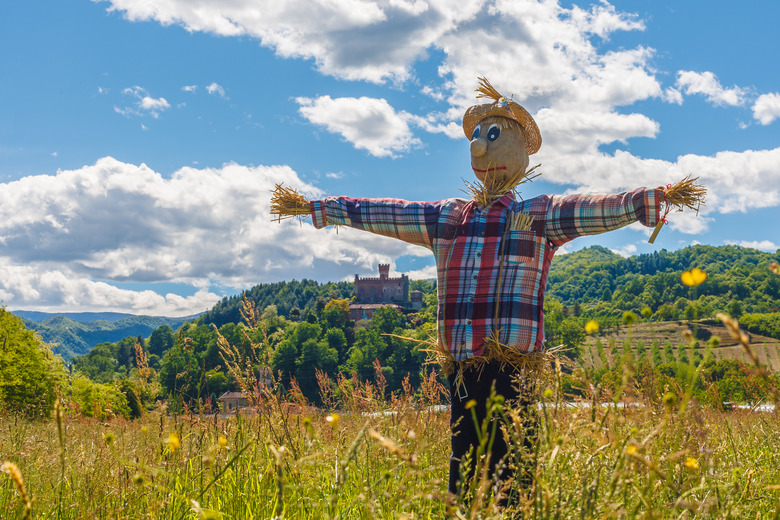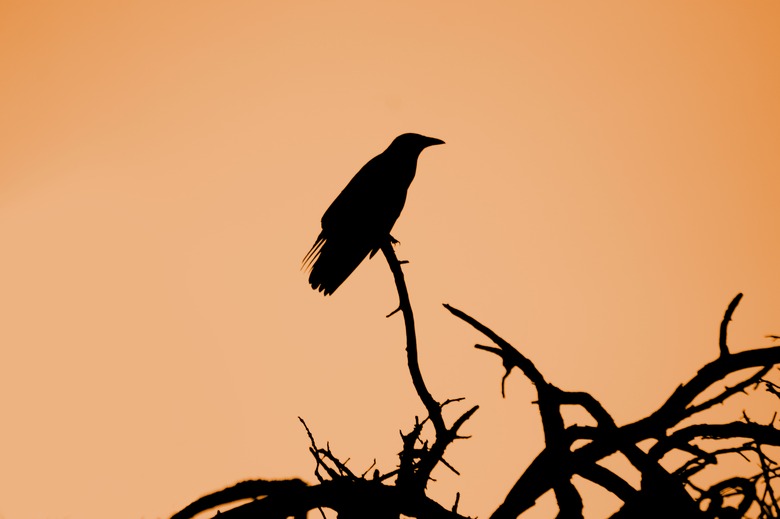How Does A Scarecrow Scare Birds?
A scarecrow scares birds by startling them into believing there's danger. Nontraditional methods such as loud sounds or random movements, however, work best at keeping your garden bird-free.
As the name suggests, scarecrows work by frightening birds. **A traditional scarecrow resembling a human figure works briefly, but crows quickly learn there is no danger and return to feast on your crops.** Nontraditional methods for keeping birds at bay are more successful.
Do Scarecrows Keep Birds Away?
While a traditional scarecrow stuffed with hay may seem like the ideal addition to a field, it's not an effective bird deterrent.
Why Scarecrows Don't Work
Crows are smart creatures. They quickly learn that the form standing still in the corn is not a threat, and they remember that. Kat McGowan, writing for the National Audubon Society, notes that crows, like primates, have large forebrains. They use tools, play tricks, recognize individual humans, and even hold wakes for their dead kin.
Scarecrows Must Have Moving Parts
To have any success with a traditional scarecrow, it must have moving parts. This can be as simple as a shirt that flaps erratically in the wind, but if there is no wind, there is nothing to startle the crows.
Lightweight polyester strips that catch the slightest breeze or shiny CDs and pie pans suspended on thread might cause a crow or two to move along. Relocating the scarecrow to a different part of the garden daily can help.
Tip
If you do decide to make a scarecrow, make sure it has moving parts, like lightweight polyester strips that catch the slightest breeze or shiny CDs and pie pans suspended on threads. Moving the scarecrow to different parts of your garden on a daily basis will help too.
High-Tech Scarecrows
For thousands of years, farmers have used variations on the human form to protect their crops, but you don't need an effigy to scare crows. In fact, some high-tech solutions are much more effective and easier to use than a straw-stuffed shirt and a pair of old jeans. However, most of those solutions require a greater investment of money or resources.
RoBird & ProHawk
The RoBird is a remote-controlled drone with flapping wings that frightens crows with its raptor-like appearance. The product is not widely available and is mostly used at airports to protect airplanes from bird strikes.
A similar flying deterrent, the ProHawk, is a GPS-guided quadcopter that broadcasts the sounds of birds in distress and the calls of predators.
Sonic Bird Cannon
If you don't have neighbors, consider a sonic bird cannon. The propane-powered "bird banger" keeps birds away with loud booms that sound like gunfire.
Motion-Detecting Sprinklers
If you have neighbors, use motion-detecting sprinklers that drench birds with water when they venture too near.
Bird Distress Calls
The most low-tech of the high-tech solutions is a simple recording of bird distress calls played through a speaker in the garden or field.
Ways to Keep Crows Away from Small Gardens
If fruits and vegetables in the garden are being damaged, try to make sure crows are the culprits before you take further action.
Additionally, the Humane Society of the United States points out that crows can rid your garden of as many as 40,000 insect pests in a single season.
If you do find the birds are causing more harm than good, however, there are ways to keep them out of your yard and garden.
Don't Leave Out Food Sources that Might Attract Crows to Your Yard
In the yard, secure your trash cans with tight-fitting lids. Don't leave your pet's bowls outside, and use birdfeeders that aren't accessible to large birds like crows. Clean up the seed that spills out of the birdfeeder, and don't put food waste in your outdoor compost pile.
Set Up Barriers to Keep Birds Out
Drape bird netting over the plants and use fabric row covers when seedlings begin to grow. Make a grid of fishing line or wire over the plants but high enough to walk under, and tie polyester strips or reflective tape along the grid.
Hang Up Fake Crows
Crows are disturbed by what they perceive as dead crows. Find fake crows at the Halloween store or online and hang them upside down in the garden with the wings spread.

